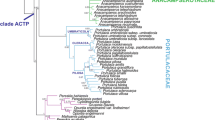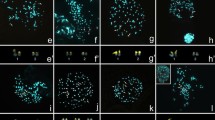Abstract
The tribe Convallarieae, comprising 10 genera and 95 species, has recently been transferred from its own family to Ruscaceae sensu lato. In this study, sequence data from trnK and rbcL were analyzed for 19 species in 8 genera, and chromosome morphology was analyzed for 17 species in 7 genera. The parsimony analysis of trnK and rbcL sequences showed that Convallarieae are monophyletic. Although early branches did not receive strong bootstrap support, Convallaria diverged at the first branch, followed by Speirantha. The rest of the tribe was split into three, well-supported clades: one with Reineckea, the second with Campylandra and Rohdea, and the third with Tupistra, Tricalistra, and Aspidistra. Two monotypic genera, Rohdea and Tricalistra, were embedded in a clade of Campylandra and of Tupistra, respectively. Three karyotypes were distinguished in the tribe on the basis of the basic number and morphology of metaphase chromosomes: Convallaria type (with x=19 and unimodal chromosome length), Tupistra type (with x=19 and trimodal chromosome length), and Aspidistra-elatior type (with x=18 and trimodal chromosome length). The character-state distribution in the molecular tree showed that the Convallaria type is plesiomorphic, from which was derived the Tupistra type and subsequently the Aspidistra-elatior type. Taxonomic treatments to transfer Campylandra to Rohdea and Tricalistra to Tupistra are also given.




Similar content being viewed by others
Notes
In the published data, five karyotypes are recognized within Convallarieae following the classification of Stebbins (1971) : 1A, 1B, 2B, 2C and 3C. The karyotypes 1A, 1B and 2B correspond to the Convallaria type; the karyotypes 2C and 3C to the Tupistra type or Aspidistra-elatior type. As a result, the Convallaria type is further found in Speirantha gardenii, Campylandra annulata (H. Li and J.L. Huang) M.N. Tamura et al., C. chinensis, C. ensifolia (F.T. Wang and Tang) M.N. Tamura et al., C. longipedunculata (F.T. Wang and S. Yun Liang) M.N. Tamura et al., C. wattii C.B. Clarke, C. yunnanensis (F.T. Wang and S. Yun Liang) M.N. Tamura et al., and Tupistra nutans Wall. The Tupistra type is also found in Tupistra grandistigma F.T. Wang and S. Yun Liang, Aspidistra caespitosa C. Pei, A. leshanensis K.Y. Lang and Z.Y. Zhu, A. oblanceifolia F.T. Wang and K.Y. Lang, A. omeiensis Z.Y. Zhu and J.L. Zhang, A. sichuanensis K.Y. Lang and Z.Y. Zhu, and A. zongbayi K.Y. Lang and Z.Y. Zhu. The Aspidistra-elatior type is also found in Aspidistra mushaensis Hayata.
References
APG (The Angiosperm Phylogeny Group) II (2003) An update of the Angiosperm Phylogeny Group classification for the orders and families of flowering plants. Bot J Linn Soc 141:399–436
Conran JG, Tamura MN (1998) Convallariaceae. In: Kubitzki K (ed) The families and genera of vascular plants, vol. 3. Springer, Berlin Heidelberg, New York, pp 186–198
Dahlgren RMT, Clifford HT, Yeo PF (1985) The families of the monocotyledons. Springer, Berlin
Fedorov AA (1969) Chromosome numbers of flowering plants (in Russian). V. L. Komarov Botanical Institute, St. Petersburg
Fuse S, Tamura MN (2000) A phylogenetic analysis of the plastid matK gene with emphasis on Melanthiaceae sensu lato. Plant Biol 2:415–427
Goldblatt P (1981) Index to plant chromosome numbers 1975–1978. Missouri Botanical Garden, St. Louis
Goldblatt P (1984) Index to plant chromosome numbers 1979–1981. Missouri Botanical Garden, St. Louis
Goldblatt P (1985) Index to plant chromosome numbers 1982–1983. Missouri Botanical Garden, St. Louis
Goldblatt P (1988) Index to plant chromosome numbers 1984–1985. Missouri Botanical Garden, St. Louis
Goldblatt P, Johnson DE (1990) Index to plant chromosome numbers 1986–1987. Missouri Botanical Garden, St. Louis
Goldblatt P, Johnson DE (1991) Index to plant chromosome numbers 1988–1989. Missouri Botanical Garden, St. Louis
Goldblatt P, Johnson DE (1994) Index to plant chromosome numbers 1990–1991. Missouri Botanical Garden, St. Louis
Goldblatt P, Johnson DE (1996) Index to plant chromosome numbers 1992–1993. Missouri Botanical Garden, St. Louis
Goldblatt P, Johnson DE (1998) Index to plant chromosome numbers 1994–1995. Missouri Botanical Garden, St. Louis
Hodkinson TR, Chase MW, Lledó MD, Salamin N, Renvoize SA (2002) Phylogenetics of Miscanthus, Saccharum and related genera (Saccharinae, Andropogoneae, Poaceae) based on DNA sequences from ITS nuclear ribosomal DNA and plastid trnL intron and trnL-F intergenic spacers. J Plant Res 115:381–392
Hong DY, Lang KY, Zhang ZX (1986) A cytotaxonomic study on the genus Aspidistra (Liliaceae) (1) — karyotypes of 7 species from Sichuan (in Chinese with English summary). Acta Phytotax Sin 24:353–361
Huang JL, Li H, Gu ZJ, Liu XZ (1989) Karyotype studies in six taxa of Tupistra (Liliaceae) (in Chinese with English summary). Acta Bot Yunnan 11:343–349
Huang JL, Li H, Liu XZ (1990) Karyotype study on four species of Tupistra (in Chinese with English summary). Acta Bot Yunnan (Suppl) 3:62–66
Levan A, Fredga K, Sandberg AA (1964) Nomenclature for centromeric position on chromosomes. Hereditas 52:201–220
Moore RJ (1973) Index to plant chromosome numbers 1967–1971. Oosthoek’s Uitgeversmaatschappij B. V., Utrecht
Moore RJ (1977) Index to plant chromosome numbers for 1973/1974. Bohn, Scheltema and Holkema, Utrecht
Rudall PJ, Conran JG, Chase MW (2000) Systematics of Ruscaceae/Convallariaceae: a combined morphological and molecular investigation. Bot J Linn Soc 134:73–92
Shang ZY, Li RJ, Cui TC (1992) Report on karyotypes of 10 species of Liliaceae (s. l.) from Qinling Range (in Chinese with English summary). Acta Phytotax Sin 30:438–449
Stebbins GL (1971) Chromosomal evolution in higher plants. Edward Arnold, London
Swofford DL (2001) PAUP*: phylogenetic analysis using parsimony (*and other methods), version 4.0 beta 8. Sinauer, Sunderland
Swofford DL, Olsen GJ, Waddell PJ, Hillis DM (1996) Phylogenetic inference. In: Hillis DM, Moritz C, Mable BK (eds) Molecular systematics, 2nd edn. Sinauer, Sunderland, pp 407–514
Takhtajan A (1997) Diversity and classification of flowering plants. Columbia University Press, New York
Tamura MN (1993) Biosystematic studies on the genus Polygonatum (Liliaceae). III. Morphology of staminal filaments and karyology of eleven Eurasian species. Bot Jahrb Syst 115:1–26
Uchino A, Miyazaki T (1982) Karyotype of Convallaria keisukei from southmost populations. Chromosome Inf Serv 33:25–27
Utech FH (1979) Floral vascular anatomy of the Himalayan Theropogon pallidus Maxim. (Liliaceae-Convallarieae). Ann Carnegie Mus 48:25–41
Wu ZY, Raven PH (2000) Flora of China, vol. 24. Missouri Botanical Garden, St. Louis; Sciences Press, Beijing
Yamashita J, Tamura MN (2000) Molecular phylogeny of the Convallariaceae (Asparagales). In: Wilson KL, Morrison DA (eds) Monocots: systematics and evolution. CSIRO, Melbourne, pp 387–400
Yang QE, Hong DY (1993) Karyotype study of the genus Theropogon (in Chinese with English summary). Acta Bot Yunnan 15:263–268
Acknowledgements
We extend our cordial gratitude to Hiroshi Tobe for invaluable comments and also critical reading of the manuscript. We are grateful to Mikinori Ogisu, Kazumi Tsuchiya, H.T. Hung and Tomohisa Yukawa for supplying us with the materials used in the study. We are much indebted to Fading Pu, Chaolu Liu, and Ching-I Peng and the staff members of BKF Herbarium, Royal Forest Department (Thailand) who assisted in our fieldwork. The study was supported in part by Grants-in-Aid for Scientific Research (11640701 and 14405012) from the Ministry of Education, Science and Culture, Japan.
Author information
Authors and Affiliations
Corresponding author
Rights and permissions
About this article
Cite this article
Yamashita, J., Tamura, M.N. Phylogenetic analyses and chromosome evolution in Convallarieae (Ruscaceae sensu lato), with some taxonomic treatments. J Plant Res 117, 363–370 (2004). https://doi.org/10.1007/s10265-004-0169-z
Received:
Accepted:
Published:
Issue Date:
DOI: https://doi.org/10.1007/s10265-004-0169-z




